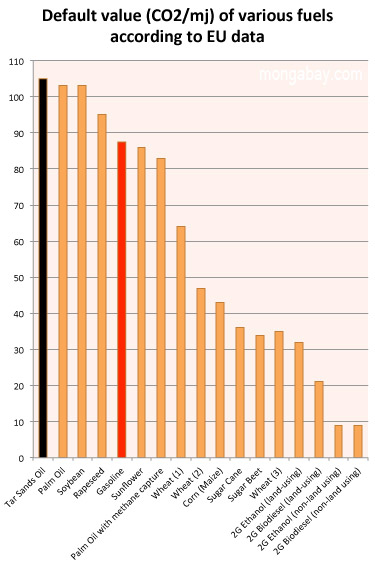Emissions from palm oil biodiesel highest of major biofuels, says EU
Greenhouse gas emissions from palm oil-based biodiesel are the highest among major biofuels when the effects of deforestation and peatlands degradation are considered, according to calculations by the European Commission
mongabay.com | January 30, 2012
The emissions estimates, which haven't been officially released, have important implications for the biofuels industry in Europe.
As reported by EurActiv, the data from the E.U. shows emissions from biofuels produced from palm oil (105g of carbon dioxide equivalent per megajoule of fuel), soybeans (103g CO2e/mj), and rapeseed (canola) (95g CO2e/mj) are higher than conventional gasoline (87.5g CO2e/mj).
WHEAT: (1) process fuel not specified (2) as process fuel natural gas used in CHP (3) straw as process fuel in CHP plants.
Sunflower (86g CO2e/mj) and biodiesel produced from palm oil with methane capture (83g CO2e/mj) are only slightly better than conventional crude oil, according to the data.
Wheat (47-64g CO2e/mj), corn (maize) (43g CO2e/mj), sugar cane (36g CO2e/mj), and sugar beet (34g CO2e/mj) were substantially lower in terms of emissions. All four were bested by "second generation" biofuels.
Fuel produced from tar sands ranked the worst of all fuels at 107g CO2e/mj. The U.S. recently blocked the Keystone pipeline, which would have enabled faster exploitation of tar sands oil.
But the findings are bound to be controversial. Emissions estimates depend heavily on assumptions on how biofuels are produced. Palm oil producers who have established plantations without converting rainforest or draining carbon-rich peatlands are bound to have lower emissions than those who destroyed forest.
The palm oil industry has traditionally opposed any effort to include indirect land use change in emissions estimates, arguing that environmental concerns over palm oil production is merely thinly veiled protectionism. Environmentalists and carbon scientists however usually disagree, arguing that conversion of forests and peatlands is a major source of greenhouse gas emissions.
Read more... Sphere: Related Content










No comments:
Post a Comment